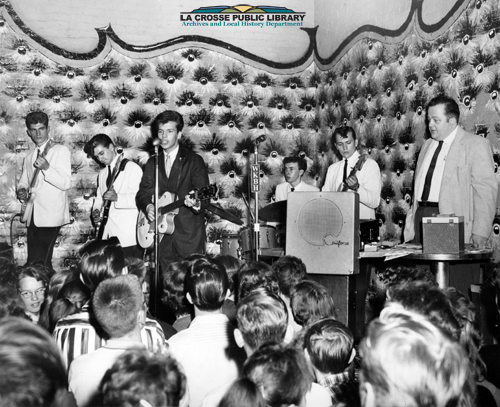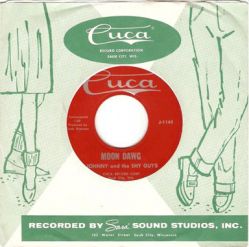
Vinyl Preservation (Like a Record)
(Written by Hannah Weber, Archives staff)
While digital downloads and music streaming services continue to dominate as the most popular ways in which music is purchased and consumed in the United States, within the past 10 years vinyl record sales have seen a resurgence of their own. Whether this growing population of vinyl listeners is made up of people who are dusting off their own collections, building new collections, or are acquiring those of family and friends, it’s certain that many people are revisiting and investing in this classic musical format. Whether you fall into this growing population of vinyl listeners and collectors or are looking to join, below are some guidelines on best practices for preserving your vinyl collection.

The Super Phonics and Lindy Shannon play at the Y.W.C.A. in La Crosse in 1959
When storing your vinyl collection, never stack your records on top of one another in a pile. Stacking places pressure on the discs and can cause them to warp, which in turn causes distortion during playback. Best practice is to store albums upright on a sturdy shelf. When placing many albums next to one another on a shelf, supporting dividers should be placed between albums every 100-150mm for additional support.
Vinyl is very fragile and is especially susceptible to damage by light, heat, dust, and moisture. Therefore, it is very important to keep your collection out of direct sunlight and in a cool location. The ideal temperature range in which to store your collection is 55-70 degrees Fahrenheit with 30-55% RH humidity. If you do not have air conditioning in the summer, try to keep your albums in a cool portion of the house with low humidity, so not the basement. Basements, while cool and dark are also often susceptible to high humidity and water leaks, which can damage vinyl. Keeping a record collection in a warm, sunny, and humid location can cause the vinyl itself to melt or warp, the plastic slip cover or dust cover to melt onto the record, or cause mold growth on the album rendering it useless.


Copies of "Johnny and the Shy Guys" 45s, recorded in Sauk City and La Crosse during the 1960s
Dust is another major culprit. It can cause scratches on the fragile grooves of a record, which in turn causes crackling, pops, and distortion when playing the record. In some extreme instances, scratches can be so severe that they will cause the stylus to skip a groove or even become stuck in the same groove playing an endless loop, hence the phrase “a broken record.” To protect your collection from dust, always put away records after listening to them; never leave them on your turntable. It is also important to remember to close the lid of your turntable to prevent dust from settling on the turntable or the stylus. Always keep the record in its sleeve within the album cover, and always keep the album cover in a plastic slip cover to prevent dust from settling in the record during storage.
When taking a record out of the slip cover, never touch the grooved portion of a record. Vinyl should be handled using the edges and the center label only. Records should be cleaned before play to remove dust particles on the surface. You should do this using an appropriate carbon fiber or vinyl record cleaning brush and antistatic treatment, as needed. This can be done by playing the record slowly and gently holding the brush over the vinyl. In addition, be sure to clean your turntable regularly and keep it free from dust or other pollutants.
When playing, it is better to use the automatic play function on your turntable, rather than placing the stylus yourself on the record. With even a slightly shaking hand, manually placing the stylus on the record can cause scratches. Always close the lid of the turntable during playback to avoid the settling of dust and debris on the record. Avoid flexing, bending, or applying pressure to the album. The groves on the disk can very easily be scratched, and even tiny scratches can cause cracking and hissing when played.
Following these guidelines should help ensure your record collection lasts and performs well for many years to come. If you have additional questions about preserving personal archival collections, please reach out the staff at the La Crosse Public Library Archives.
Resources Referenced:
Curtis, J. (n.d.). LP (Long Play) 12 inch record (1948-). Retrieved from http://www.obsoletemedia.org/lp/
Friedlander, J. (2016). News and Notes on 2016 Mid-Year RIAA Music Shipment and Revenue Statistics. Retrieved from http://www.riaa.com/wp-content/uploads/2016/09/RIAA_Midyear_2016Final.pdf
National Archives and Records Administration. (2016, August 15). Audio Guidance. Retrieved from https://www.archives.gov/preservation/formats/audio-toc.html
National Archives and Records Administration. (2016, August 15). Audio and Video Guidance: Resources. Retrieved from https://www.archives.gov/preservation/formats/audio-video-resources.html
National Film and Sound Archive of Australia. (n.d.). Preservation at Home: Caring for Audio. Retrieved from https://www.nfsa.gov.au/preservation/home/caring-audio
National Library of New Zealand. (n.d.). Caring for your Collections: Sound Recordings. Retrieved from http://natlib.govt.nz/collections/caring-for-your-collections/sound-recordings
Popsike. (2009, September 3). Johnny and the Shy Guys- Pretty Baby/Teen/I Hear it [photograph]. Retrieved from http://www.popsike.com/Johnny-and-the-Shy-Guys-Pretty-Baby-TEEN-HEAR-IT/140343806854.html
Popsike. (2012, May 21). Surf Guitar Instrumental Rocker-Johnny & the Shy Guys-“Moon Dawg”-Cuca 1145 [photograph]. Retrieved from http://www.popsike.com/SURF-GUITAR-INSTRUMENTAL-ROCKER-JOHNNY-THE-SHY-GUYS-MOON-DAWG-CUCA-1145/300714325647.html

